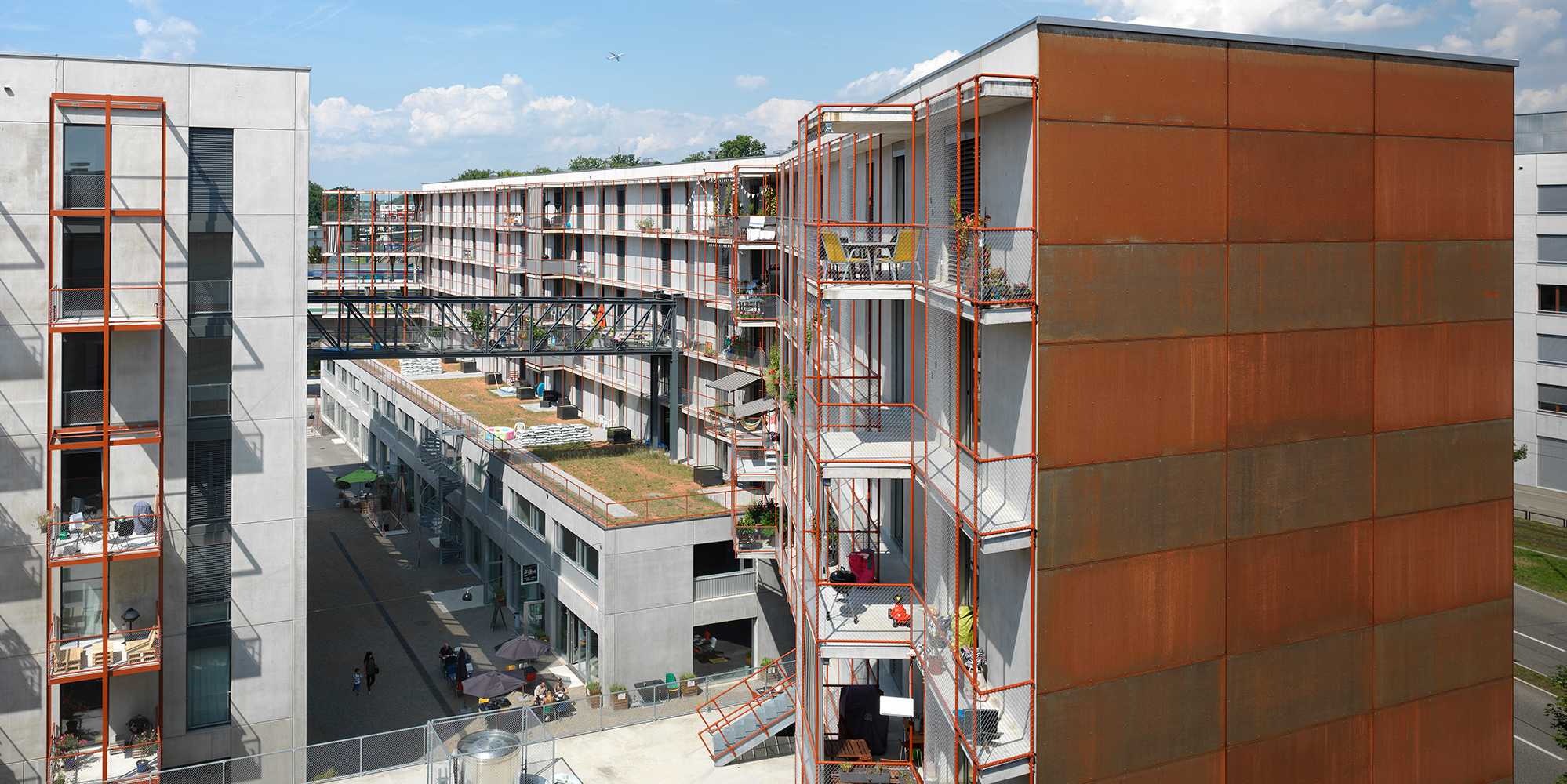“Vertical extensions of buildings are becoming a key option for urban redevelopment”
Why are more new housing units being constructed in Geneva each year, while Zurich is seeing a decline? Why are older residential buildings in Basel, Geneva and Lausanne being vertically extended, while they are being demolished and replaced in Zurich? ETH researchers provide new answers to the role of housing construction and its social impact.

In brief
- In Basel, Bern, Geneva, Lausanne, and Zurich, housing construction has increasingly contributed to urban densification over the past twenty years.
- Replacement buildings, vertical extensions, and the conversion of industrial and commercial sites play a key role in densification – with notable differences across Switzerland’s five largest urban agglomerations.
- While replacement constructions are often associated with higher rents and the displacement of tenants, vertical extensions tend to allow for a more socially balanced form of densification. In French-speaking Switzerland, displacement is comparatively less pronounced.
David Kaufmann, you’ve been investigating construction activity and displacement in urban Switzerland on behalf of the Federal Office for Housing. What was the aim of your research?
David Kaufmann: We examined the five largest agglomerations in Switzerland – Basel, Bern, Geneva, Lausanne and Zurich – to determine the extent to which housing construction is contributing to densification, which is a key objective for spatial planning in Switzerland. We also describe how the composition of the population changes when older residential buildings are renovated or replaced by new ones. This involved examining linked data sets from 2000 to 2023 from the Swiss Federal Statistical Office.
How has housing construction contributed to urban development?
In the urban areas that we examined, an increasing amount of construction is taking place within the settlement boundaries – especially in the core cities, where housing construction has become increasingly important for urban densification over the last twenty years.
How is this evident?
In the case of residential new builds, there is a clear difference between developments in core city municipalities and more central agglomeration municipalities, and those in peripheral agglomeration municipalities. While many new residential buildings have been built on previously undeveloped land in the peripheral communities of the agglomerations since 2020, an increasing majority of new residential buildings in the core cities are being built on land that is already being used. Replacement constructions, vertical extensions and converted industrial and commercial sites all play a key role.
What is the significance of converting industrial and commercial sites for housing purposes?
Compared to the early 2000s, significantly more residential buildings are now being constructed in former industrial and commercial zones. Between 2000 and 2004, the proportion of residential buildings constructed on industrial sites ranged from just 6% in Lausanne to 11% in Geneva. During the construction period 2020–2023, it was already much higher in all core cities – between 35% in Bern and 63% in Zurich. However, these conversion areas in core cities are becoming increasingly scarce, since parts of this potential have already been exploited.
How is this development reflected in residential properties?
The conversion of industrial and commercial sites is leading to high-density development projects featuring many new apartments per building. In Basel, for example, around 15% of new residential buildings were built on converted sites between 2020 and 2023. This high percentage is due in part to the fact that new residential buildings contain more apartments. This is particularly evident in Geneva and Lausanne. On the other hand, the construction of new residential buildings in all agglomerations has not increased in recent years.
What is the latest development in new residential units?
With the exception of Zurich, the number of new-build apartments has risen significantly in all the urban areas surveyed, but not the number of buildings. This indicates that housing construction is becoming denser. We examined the net increase – i.e. the number of new-build housing units less those lost through demolition. Based on a comparison of the construction periods 2000–2004 and 2020–2023, the annual net increase in housing units ranges from 34% in Bern to 110% in Geneva. Zurich by contrast, recorded an annual decline in new-build housing units of 7% during this period.
What role is being played by the replacement of buildings compared to adding additional storeys?
Between 2020 and 2023, there was significantly more demolition and replacement of residential buildings in all five agglomerations than vertical extensions or other additions to existing buildings. The ratio ranges from 1.7 times as many replacements in the Bern agglomeration to 5.4 times as many in the Zurich agglomeration. The situation is different in the core cities: only in Zurich do replacement constructions clearly predominate, with 4.1 times as many buildings replaced as vertically extended. In Basel, Bern and Geneva, however, twice as many buildings were extended than replaced. It is becoming apparent that vertical extensions are becoming a key option for urban development. This also makes a lot of sense from a sustainability perspective, as vertical extensions are more environmentally and socially sustainable than replacing existing buildings with new ones.
The report states that Basel, Geneva and Lausanne are making more effective use of their settlement areas than Bern and Zurich. What is the reason for this?
In all agglomerations, replacement buildings contain more residential units than demolished residential buildings. Compared to Bern and Zurich, Basel, Geneva and Lausanne built around 1.6 to 2 times as many additional residential units per demolished residential unit between 2020 and 2023.

“High levels of new housing construction or densification do not necessarily lead to lots of evictions if actively managed by policymakers.”David Kaufmann
Rents are often higher in replacement buildings and after complete renovations than in older buildings. What impact does this have?
When residential buildings are replaced or extensively renovated, existing tenants are evicted and the new rents are considerably higher. In the literature, we refer to this phenomenon as displacement. There are clear differences between the five agglomerations. In the Zurich area, over 14,000 people were affected between 2015 and 2020, representing 1.02% of the total population. This means that displacement was much higher in Zurich than in other urban areas. At the other end of the scale is Geneva, where 467 people, or 0.08% of the population, were displaced.
Where are these tenants moving to?
Many evicted tenants are moving within the same municipality: the figure ranges from 55% in the Lausanne agglomeration to 73% in the Zurich area. For the city of Zurich, that figure is 62%. However, further research has revealed that these people tend to move into comparatively older houses and neighbourhoods with a lower average income.
Which groups of people are particularly affected by displacement?
It mainly affects people and households on low incomes. Older people are also disproportionately affected. In addition, asylum seekers, recognised refugees and people born in African countries are disproportionately affected by displacement. Displacement therefore tends to affect people who are already socio-economically disadvantaged.
What differences do you see in the legal frameworks of the five agglomerations?
The cities have varying degrees of political autonomy: unlike Zurich, Geneva and Basel are what are termed “city states”. This gives them more leeway and allows them to tailor cantonal spatial planning instruments, cantonal building laws and tenancy laws to suit urban needs.
What does that look like in practice?
Geneva has stronger tenant protection and building regulations, but still creates more living space than Zurich. The Law on the Demolition, Conversion and Renovation of Residential Buildings (LDTR) limits rent increases after demolition and renovation, making evictions for financial reasons unattractive. At the same time, another law allows for vertical extensions. This is one reason why buildings are more often extended than replaced in Geneva. Basel-Stadt is also taking a more active approach with new stricter tenant laws and is discussing carbon pricing for housing construction. However, these laws did not come into force until after 2023, which is why our study is not able to examine their impact. There are no comparable regulations in Zurich, but political initiatives have been launched to strengthen tenant protection.
What recommendations would you make to policymakers to improve the housing situation in cities and conurbations?
Essentially, it is about more active planning and political steering aimed at achieving more sustainable urban development. This means combining measures to create more living space without demolishing buildings and displacing people. While replacement buildings can be limited through stricter tenancy regulations or CO₂ levies, new spatial planning strategies are needed to enable more sustainable residential development. In particular, vertical extensions and other soft densification measures could be increasingly promoted to enable residents to continue to live in the same buildings. Affordable housing can also be created by promoting non-profit housing developments in central locations. When demolishing houses, a very high degree of densification and phased replacement construction is advisable. This allows the former residents to return to their new homes under comparable rental conditions.
What conclusions do you draw from the differences between German-speaking and French-speaking Switzerland?
For us German-speaking Swiss, it’s worth taking a look at French-speaking Switzerland. In the Geneva and Lausanne areas, comparatively few people have been displaced, despite the fact that these regions have the highest levels of new housing construction. This shows that high levels of new housing construction or densification do not necessarily lead to a lot of evictions if actively managed by policymakers.